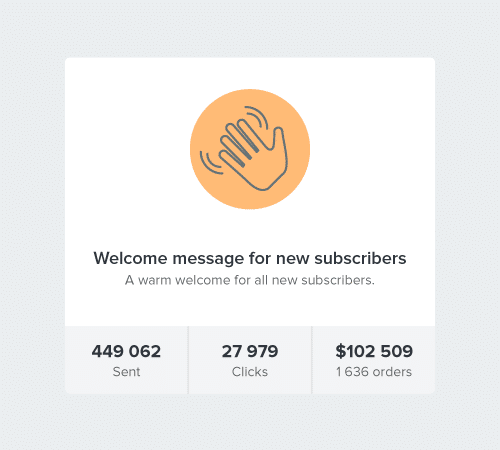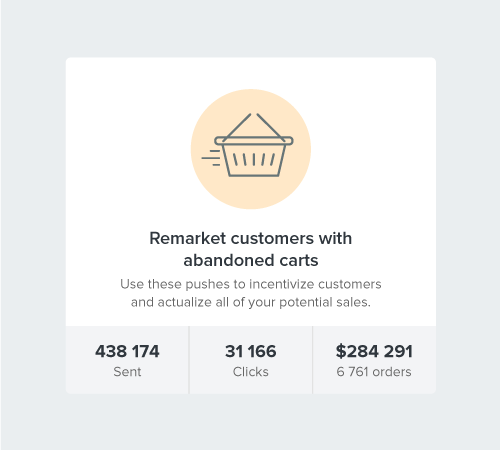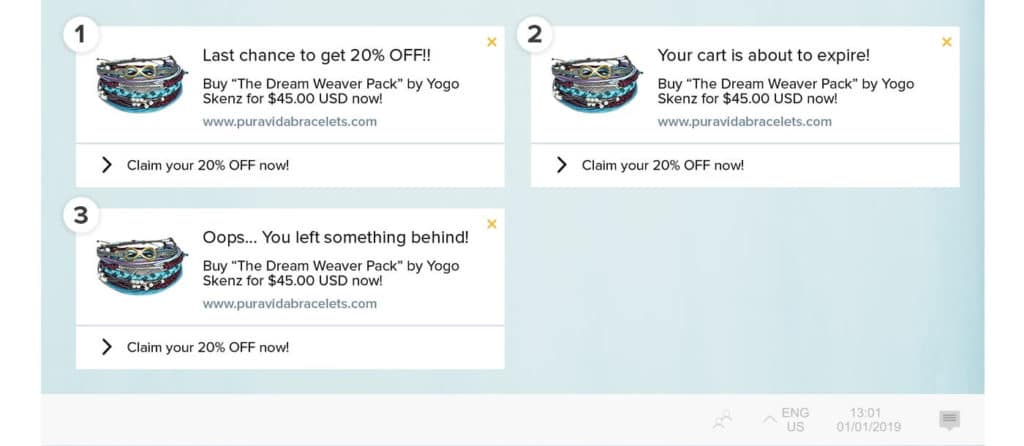Marketing automation is a powerful tool that you can use to drive sales and improve customer engagement for your e-commerce business. Particularly during the coronavirus crisis, it can become an essential tool to help you drive sales of high-in-demand products, while also saving you a whole heap of time and human resources to implement these marketing activities.
This article highlights in detail the benefits that marketing automation can bring to you as an online store owner. It also covers how you can get started implementing marketing automation into your business. Let’s dive right in by understanding what marketing automation is all about.
What is marketing automation?
In an ideal world, your marketing activities should be closely aligned with your sales objectives (but this isn’t always the case!). Marketing automation software helps you bring your sales and marketing activities together.
It can streamline and simplify your lead generation processes, helping you turn cold leads into potential buyers (warm leads), before finally turning them into paying customers. Marketing automation also helps you to nurture and retain existing customers so that you can increase their lifetime value to your business.
Marketing automation strategies – example scenario
So you can see how marketing automation might work for your e-commerce business, check out this example below.
Let’s say that ‘Rachel’ has an online store selling organic beauty products and cosmetics. Rachel needs a way of capturing interested store visitors. So she sets up a subscriber popup form to collect email addresses or web push requests automatically. It appears to every visitor that lands on her store.
Rachel offers an incentive for signing up to marketing emails – a free eBook containing 25 makeup tips. She’s offering value to cold leads to warm them up.
Rachel then sets up an automated welcome email which gets sent out to new subscribers. In this welcome email, Rachel mentions some of her bestselling products and offers the subscriber a great discount of 25% on their first order.
Once a subscriber makes a purchase and turns into a customer, Rachel analyzes the customer’s order, to see what was purchased. The customer purchased some organic hand cream and a face mask. Rachel creates a segment in her email list and names it ‘Skincare Prospects’ and adds the customer to the segment.
One month later, Rachel is running a flash sale on her skincare range. She now has a collection of ‘Skincare Prospects’ and wants to encourage them to make a purchase. Rachel sets up a series of automated marketing emails to promote the skincare sale.
The first email is automatically sent out the day before the flash sale to generate early interest. A second email is sent out on the morning of the sale saying that stock is limited, and it includes a countdown timer to evoke a sense of urgency. A third email is sent out a few hours before the sale ends, with the countdown timer and the offer of free shipping as an incentive. All this happens automatically, while Rachel concentrates on fulfilling orders.
Rachel has a great chance of making lots of sales. She’s remarketing to warm leads – people who have made a similar purchase previously. She’s using automated email flows so that they are sent at precisely the right times – and conveying a sense of urgency in her content. And she’s including an incentive to sway the impulsive buyer.
Marketing automation software features
Some marketing automation features have been touched on above (list building and email flows), but here they’re covered in more detail. You’ll also get to learn more about other features that you may come across when researching marketing automation software.
Automated list building
Building a database of subscribers is one of the best things you can do to help drive sales for your e-commerce business. By capturing a list of interested store visitors, you’re effectively creating yourself a little goldmine that many other online store owners would (and do) pay for: quality leads.
Once you’ve got a subscriber, they are effectively a lead; someone who is potentially interested in your products. Finding leads is half the battle when it comes to making sales.
Marketing automation software helps you to capture interested prospects by presenting them with some kind of signup form and then populating subscriber details into a database. That might be a popup form that appears when someone lands on your store or is about to exit. Or it might be a subtle fly-out widget that sits discreetly at the side of the screen and only appears when the icon is clicked on.
Welcome automation and marketing flows
This type of automation is used to get your relationship with subscribers off to a great start. You can point new subscribers to your bestselling products, offer them a special discount on their first order, or tell them a bit more about your company’s mission.
Welcome flows are proven to directly improve your revenue! Ivory Ella is a Shopify Plus store that uses push notifications as part of their marketing strategy. They’ve achieved more than $100,000 in revenue directly from their welcome push messages alone (see screenshot below).
Welcome automations can be triggered across all channels, using an app like Firepush, which covers web push notifications, SMS and email marketing. You can also send out marketing automation flows to cross-sell and upsell products, promote flash sales and more.
Abandoned cart automation
Did you know that 69.57% of online shoppers abandon their carts before making a purchase? Reasons for cart abandonment vary. Some shoppers are simply browsing and comparing prices. Some get distracted by external factors, like a phone call, or the need to rush off somewhere. And others are put off their purchase because of a technical difficulty, data privacy concerns or high shipping fees.
Though it’s unlikely you’ll be able to attract every person that abandons their cart back to your store, you absolutely can capture a great many of them through the power of automated abandoned cart messages. See the key benefits of these below:
-
-
- Easy to create omnichannel abandoned cart campaigns
-
Abandoned cart messages can be sent via web push notifications or SMS, and support other channels like email. They give you a truly omnichannel way of connecting with your customers in the right place and at the right time, when they’re most likely to take action. 78% of abandoned carts happen on mobile, compared to 67% on desktop, so combining web pushes and SMS campaigns increases the chance of your messages getting seen.
Push notifications offer another advantage in relation to tackling abandoned carts. Subscribers typically sign up for these when they first land on your website, so you can track abandoned carts right away. The subscriber doesn’t need to input their email address or phone number at the checkout page before an abandoned cart message is triggered. That said, push notifications can capture a larger proportion of would-be shoppers than other channels such as SMS and email.
-
-
- Automates the process of recovering abandoned carts
-
The right app can help you take all the hassle out of abandoned cart recovery. Some apps let you set up a number of automation flows that are triggered and sent automatically. So once you’ve added creative (image and copy) elements to your campaign, you can activate them and they’ll do the hard work of recovering abandoned carts in the background. Abandoned cart automations can be a huge help for time-poor online store owners.
Examples of Shopify Plus stores using abandoned cart alerts
Some of the most successful Shopify Plus stores around are using abandoned cart messages to help drive sales and increase conversions. Going back to Ivory Ella – their most successful push notification type used is abandoned carts, bringing in $262,551 in revenue so far.
Puravida is another Shopify Plus store that’s making abandoned cart messages work hard for them. They’ve achieved more than $1 million in revenue with a low touch push notification marketing strategy, and more than $280K of that has been brought in through automated abandoned cart messages!
The below screenshot shows how Puravida has set up their abandoned cart automations. Their first automation includes a 20% discount offer. The second one promotes a sense of urgency by telling the would-be shopper that their cart is about to expire. And the third one tells them that they’ve left something behind. Note how each message includes a clear call-to-action: ‘Claim your 20% OFF now!’
Expert tip!
Here’s a very detailed abandoned carts recovery guide, which includes the best timings and sequences to follow when setting up an abandoned carts strategy. You’ll want to read the guide in full, but these are the most important things to note:
-
-
- Frequency of reminders – for every would-be shopper that leaves an item in their cart, three reminders is the magic number.
- Best timings for ROI – send your abandoned cart messages out at these specific times following cart abandonment: 50 minutes, 8 hours and 23 hours.
- Use the cheapest channel first – web push notifications are the most cost-effective marketing channel. So send out your abandoned cart alerts by web push first, and if you don’t get the desired result, follow up with an SMS reminder. SMS marketing is very effective but it is more expensive to implement.
-
Automated back in stock alerts
An easy way to retarget potential customers is by activating back in stock alerts. Using marketing automation software, you can set this up to appear on product pages within your store. Interested visitors can simply request to be notified when an item they like is back in stock.
As soon as you restock items in your store and make the necessary adjustments to the back-end of your website, those subscribers will be instantly alerted, helping you to generate more sales on autopilot.
Automated review requests
Another marketing automation feature you may come across is the ability to ask customers to leave a review following their purchase. Using the right software, you can schedule review requests to be sent out at a time you choose, for example, a couple of weeks after the order has been placed or dispatched.
Customers tend to trust other customers more than they trust brands. So reviews are crucial in helping you build social proof and give prospective buyers confidence.
Automated order confirmations and delivery updates
Marketing automation doesn’t have to end when you land a sale! Automated order confirmations and dispatch communications can help you follow up with customers to reassure them about their order and reduce post-purchase anxiety.
Marketing automation tools for e-commerce – getting started
There are several marketing automation tools and apps on the market today that suit different e-commerce platforms. When researching your options, think about the processes that you want or need to automate. Check out the features that each app offers and most importantly, read the reviews from other e-commerce clients.
Choose a marketing automation tool that’s well established and has a solid reputation in the e-commerce industry. If your store is built on Shopify, you can see Firepush and other marketing automation apps in the Shopify App Store.
Author bio: Ieva Dauderyte heads up digital marketing at Firepush, a successful omnichannel marketing app, that helps Shopify stores drive sales, improve conversions and increase customer lifetime value.



















